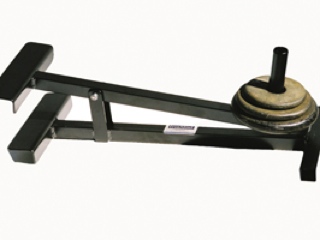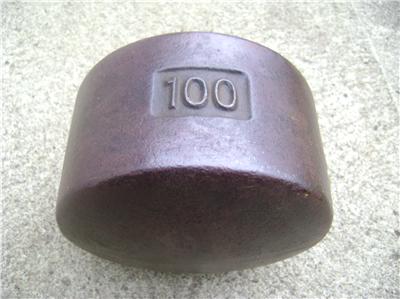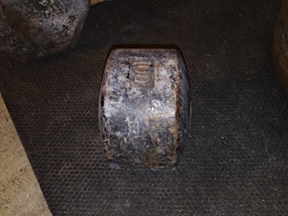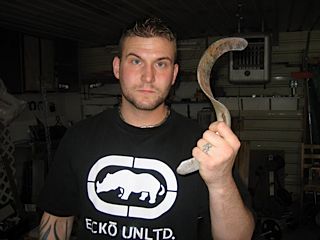Fight Geek just pointed me to a very unusual sport. Just watch.
Results matching “thumb”
Trainers, coaches and athletes have asked how they can use their kettlebells to increase their Grip strength. The truth is, kettlebells can be used with the express purpose of building Grip strength. We showed many ways to make this work in our Advanced Kettlebell Techniques eBook series. With this article I will show how easy it is to turn just about any kettlebell you have into a piece of Grip enhancing weaponry.
Before we get into this exercise, I first want to explain that it is important to remember that Grip strength is not just about picking things up and holding them there. Grip's more than lifting the Blob or the Inch Dumbbell. There's more to it than closing heavy grippers. Grip strength is even much more than just bending nails.
Grip strength involves all of the musculature from the elbow down. This includes all of the muscles in the forearm, everything that crosses the wrist, everything that controls the thumb, everything that rotates the forearm and all of the muscles that open and close the hand.
When it comes to developing well rounded Grip strength, you must train all of the functions of the hands and the forearms in the right balance. This means including enough extensor work to balance all of the crushing, pinching and supporting you do. It means including work of the elbow flexors with the hand pronated in order to prevent the development of epicondylitis, tendon inflammation, and other forms of overuse injury. And it means you must train your wrists in a variety of angles.
When thinking of wrist training, attacking from many different angles is important. Remember, a great deal of muscles that pinch, crush, and support cross the wrist. As a result, continuity of the wrist musculature and bones is necessary in order to properly transfer strength across that joint.
Mighty Joe Musselwhite has put together a brilliant series of arm-wrestling tip videos, beginning with this one - Finger Pressure. Good stuff.
I have competed in many Grip Strength competitions over the years. I have trained and competed with some of the best in the sport of Grip and I think I have collected a wide range of knowledge on the subject. I was recently asked in an interview if I though Grip Strength Training was important for athletes outside of the sport of Grip. Without a doubt, I think it is very important to dedicate time in the athlete's training routine to developing solid hand strength, but I also think that some ways are better than others. In my opinion, one of the best types of Grip training for general athletes is Pinch Grip Training.
There are many ways to train the Pinch Grip. In this article, we will look at a few of those ways. You will see videos of Pinch Grip feats and training styles and then I will discuss possible carryover to the sport of grip and other sports with each technique.
First, is a clip from the 2007 grip contest at Total Performance Sports, the Grip Assault. In this clip, I am messing around with a 56-lb Scottish Highland Games Throwing Weight.
As you can see, this is a feat that is suited best for a person with large hands. A smaller handed individual may not be able to spread their fingers far enough to get the fingertips over the edge of the weight.
If you have smaller hands, there is no reason why you still can't train in this style, though. Just find weights that are smaller in size. Block weight training is great because it forces you to lift things with an open hand. Open hand strength training makes the full length of the musculature and tendonous masses work in order to lift the weight. With open hand training, you really feel it throughout your entire hand the next day.
When I do wide pinching, like in the video above, I feel the fatigue from the fingertips to the base of the fingers, through the palm and into the wrist. The majority of my grip workouts involve thick block weight training, yet I still see continued increases in my other lifts. To me, that means there is better carry over in wider lifts than narrower lifts, especially if your training goal is excellent performance in Grip Contests, like me.
Even if Grip Competitions are not your interest, I still suggest that open hand training be a main focus in your grip protocol. If it carries over well to other grip lifts, it will carry over to other gym lifts and other sports as well.
Next, in this video, I'm pinching two 45-lb plates & lift a Half 115-lb Hex Block Weight.
I would consider the Two 45's Pinch feat to be a mid-range pinch feat for me, personally. The two 45-lb plates fit securely in my hand, just about the size of my palm.
The Half 115 Pinch is getting out of the mid-range and moving toward the wide pinch range, although not nearly as wide as the 56-lb weight pinch. Again, the half 115 is going to be much more difficult for a person with smaller hands. It is a rather narrow half 115 compared to some of the other ones I own, but for someone with sub-8-inch hands, it will seem huge.
More from Odin - this time a thumbless RT lift. Nice one.

The focus of this article will be Dynamic thumb training with the Titan's Telegraph Key, or TTK, manufactured by IronMind Enterprises, but very quickly, I will touch on the other divisions as well.
STATIC THUMB TRAINING
Static Thumb Training is where the athlete pinches something and the thumb, for the most part, does not move over a Range of Motion. This is the way that probably 90% of pinch work is executed, I'd venture to guess. Examples are Plate Pinches and Block Weight Lifts. Here is a video of Plate Pinches and Block Weight Lifts:
EXTENSOR THUMB TRAINING
Extensor Thumb Training is where the muscles on the back of the thumb are the primary muscle group being worked. Rubber band training is a very simple example of the thumb extensors being worked. Here is a video demonstration:
MULTI-PLANAR THUMB TRAINING
I find that Multi-Planar Thumb Training is an excellent way to keep all of the muscles in the thumb healthy and strong. I accomplish this with a bucket of sand. Essentially all I do is stick my thumb into the sand bucket and stir the sand around until the muscles powering the thumb are flushed with blood. Once you feel the pump through your thumb, you can also do some deep tissue massage to work out any kinks. Believe me, if you have any imbalances or adhesions in the muscles in the thumb, you will find out where they are with this exercise. Unfortunately, not a lot of grip strength trainees know about this technique that can help them out so much. Here's a clip:
DYNAMIC THUMB TRAINING
Dynamic Thumb Training is where the thumb moves over a distance. One of the implements that I have been using for Dynamic Thumb work is the Titan Telegraph Key, or TTK. There are other implements on the market that are very similar that you can pick up that have other names, but they all work on the same principle: the fingers and thumb oppose on another, positioned on two separate plates; resistance is placed at the end of a lever arm; and thumb strength is used to move the resistance.


Recently, there has been some confusion about true Blobs, and it is my goal with this article to set the records straight so that the new athletes who are entering the ranks of the sport of Grip strength can be clear about what they are purchasing and training with. After all, it wasn't too long ago that a new grip trainee wrote in about purchasing what he thought was a legitimate blob only to find out he had been misled in the deal. Here we go.
The Original Blobs

True Original Blobs are very rare for many reasons. One thing that makes them rare is credited to their color. Because they are a dark brown to black color, they do not look like the flashy, silvery colored dumbbells that are so common in gyms and health clubs today. For that reason, they are often discarded and replaced by "nicer looking" dumbbells.
I recently heard a story from a friend in New York state. He said he was checking out gyms to see if they had any of these dumbbells and he was told that they had just swapped out their old dumbbells for new ones. Where'd the old ones end up? The dumpster. Now that's a crying shame.
The version of York dumbbell that Richard Sorin first trained on and named looks much like the Blobs that many Grip enthusiasts currently own, but are actually a bit different and more difficult to lift.

If you really take a hard look at the original style Blobs, both sides of them curve out almost equally. This curvature on both sides of the blob is what makes them so much more difficult to lift that the blobs that many of us have run across today. It is very difficult to get any kind of dig or bite with the thumb like can be done on the next generation of Blobs.
York Blob Replicas

As noted, one edge of this generation of Blob is straighter than the original. Experienced lifters know that the most advantageous way to situate their hand when lifting the Blob is to put the thumb against the straighter side and the fingers along the side that is more curved. Since the thumb is the weakest part of the hand in this equation, it needs to get any advantage it can when you are lifting the Blob. This advantage is attained by digging it into the sharper edge of the blob.

On the Gripboard, I maintain the Records Lists for many established feats of Grip Strength. There is a list dedicated to Blob lifts there, and because of the rarity of true blobs, these York Replicas are also honored for that list.
In Summer 2003, I picked up a 100-lb dumbbell from York, right at their facility. Shortly after this time I began hearing and reading that York would be stopping the production of this style of dumbbell, hence cutting production of new Blobs. Ever since then, half 50's from old York dumbbells have gotten more and more rare...

Every PR leaves a trophy. It is a truly manly activity, and it is in danger of being a lost art in today's namby-pamby metrosexual American fitness scene. Rest assured there is nothing soft, weak or manicured about destroying steel. My goal is to stop the madness, and restore this destructive science to its proper place in strength and conditioning. Perhaps you believe this is too hardcore for you, the weekend warrior who just wants to be healthy? I hope after reading this you will see there is a place in the bending world for you.
Short bending is one of the greatest ways to build true power and endurance in the lower arms, but its effects are not just experienced in the arms. You will build your chest, shoulders, lats, traps and abs while bending. You will benefit across the whole spectrum from muscle hypertrophy to power to endurance. I will discuss this in detail.
First benefit is to your neural strength: Steel bending is an exceptional way to build your single unit application of tension. What I mean is this - you have to tense and load every muscle in your body, take out all "leakages", brace everything together and direct it through you hands with a sniper's precise angle. If you get sloppy punching on the nails ends, you will hurt yourself. You could possibly punch yourself in the face, roll your hands out of the groove, stab yourself, or any other combination of less desirable outcomes. This activity will turn your wrist to stone. Your ability to direct power will be significantly increased. This will directly carry over to any other strength-skill you currently have. The way I load up to bend a Huge Stainless Steel Bastard is exactly the same feeling as when I load up to pull a max dead, to press a 48kg bell, or to slam an axe through a log. It adds a critical power appliance to your "strength skill tool box".
This increase in strength and power naturally will carry over to an increase in your endurance. Anyone who has bent a nail will tell you the first time they bent it was so tiring. I have watched people sweat bullets bending their first respectable nail. As time goes on you gain huge reserves of power. A personal testament to this level of power for me was October 2007 when I bent 150 60D nails in one hour using the double under (DU) grip. That represented a massive improvement from Jan 2007, when bending 10-15 nails left my hands extremely fatigued.
Let's talk about the muscle growth. Bending is a high tension exercise. Forcing a steel bar to yield requires hundreds of pounds of force, applied for several seconds. A big bend often will take much longer than it would take for a dead lift or squat. Your muscle fibers will get much denser. If you have ever met some one who does a lot of bending, you can not help to notice the density of the forearms, chest, arms and back.
Steel bending builds real confidence. You are doing what should not be done. When you trash a piece that takes hundreds of pounds of force to bend, you can not help to feel good about the achievement. I promise you will tackle your other hobbies, sports and challenges with greater confidence and determination after going all out on a steel bar. Bending can become a powerful implement to develop an individual's mental toughness and pain tolerance. I have witnessed this effect on people from both steel bending and kettlebell lifting.


